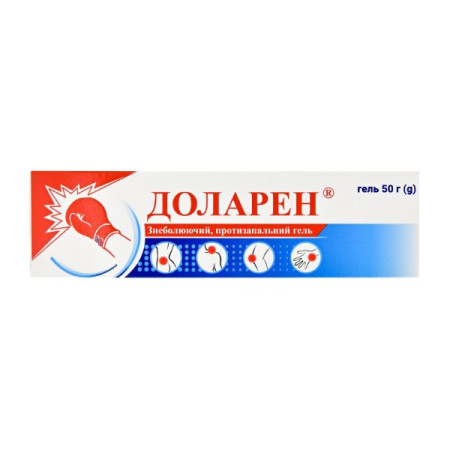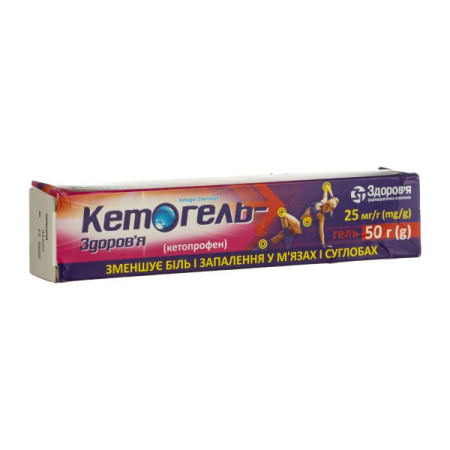Dentagel gum gel tube 20 g

Instructions Dentagel gum gel tube 20 g
Composition
active ingredients: metronidazole benzoate, chlorhexidine digluconate;
1 g of gel contains: metronidazole benzoate equivalent to metronidazole 10 mg, chlorhexidine digluconate solution 20% equivalent to chlorhexidine digluconate 0.5 mg;
excipients: carbomer, propylene glycol, sodium saccharin, disodium edetate (Trilon B), triethanolamine, peppermint oil, purified water.
Dosage form
Gum gel.
Main physical and chemical properties: white or almost white gel with a specific odor. It should be homogeneous in appearance.
Pharmacotherapeutic group
Means for use in dentistry. Antimicrobial and antiseptic agents for topical use in dentistry.
ATX code A01A B.
Pharmacological properties
Pharmacodynamics
Antimicrobial combination drug for the complex treatment and prevention of certain infectious and inflammatory diseases of the oral cavity.
The effectiveness of the drug is due to the presence of two antibacterial components – metronidazole and chlorhexidine.
Metronidazole is a nitroimidazole derivative with antiprotozoal and antibacterial activity. It is active against anaerobic bacteria that cause periodontal disease: Porphyromonas gingivalis, Prevotella intermedia, Prevotella denticola, Fusobacterium fusiformis, Wolinella recta, Eikenella corrodens, Borrelia vincenti, Bacteroides melaninogenicus, Selenomonas spp.
Chlorhexidine is a bactericidal antiseptic. It is active against a wide range of vegetative forms of gram-negative and gram-positive microorganisms, as well as yeasts, dermatophytes, and lipophilic viruses.
Pharmacokinetics
The minimum inhibitory concentration (MIC50) of metronidazole for anaerobic bacteria is below 1 μg/ml. When the drug is applied topically (applied to the gums), the concentration of metronidazole in the gum area is significantly higher than when the drug is applied orally, and the level of systemic absorption of metronidazole when applied topically is significantly lower than when it is applied orally. The main route of excretion of metronidazole and its metabolites is the kidneys. Reduced renal function does not change the pharmacokinetics of a single dose of metronidazole.
In case of ingestion of excess chlorhexidine, during its topical application as part of a dental gel, approximately 1% of the dose that reaches the stomach is absorbed from the digestive tract. Chlorhexidine does not accumulate in the body and is minimally metabolized.
Indication
For the treatment of infectious and inflammatory diseases of the periodontal and oral mucosa.
Catarrhal, hypertrophic gingivitis, acute and chronic course.
Acute ulcerative-necrotic gingivitis (Vincent's gingivitis).
Generalized periodontitis, chronic and acute course.
Trauma to the oral mucosa caused by dentures.
Alveolitis (inflammation of the socket after tooth extraction).
For the prevention of exacerbations of chronic gingivitis and periodontitis.
Contraindication
Hypersensitivity to metronidazole, chlorhexidine, as well as nitroimidazole derivatives and any components included in the drug.
Interaction with other medicinal products and other types of interactions
When applied topically at recommended doses, no systemic interactions of Dentagel® with other drugs have been identified. However, caution should be exercised when prescribing Dentagel® with certain drugs.
Warfarin and other coumarin anticoagulants. Metronidazole enhances the anticoagulant effect, leading to a prolongation of prothrombin time.
Disulfiram. Concomitant use increases the toxicity of the drugs, which may lead to the development of neurological symptoms.
Phenobarbital, phenytoin. When used simultaneously with metronidazole, the antimicrobial activity of the latter decreases. The reason is the accelerated metabolism of metronidazole.
Cimetidine: Inhibits the metabolism of metronidazole, which may lead to an increase in the concentration of metronidazole in the blood serum.
Application features
Avoid getting the gel in your eyes.
Using Dentagel® does not replace hygienic tooth brushing.
You should not drink alcohol while using the drug, as this may cause stomach cramps, nausea, vomiting, headache, and flushing.
Ability to influence reaction speed when driving vehicles or other mechanisms
The use of the drug in the specified dose does not affect the ability to drive vehicles or potentially dangerous mechanisms.
Use during pregnancy or breastfeeding
The drug should not be used during pregnancy.
Breastfeeding should be discontinued during treatment with the drug.
Method of administration and doses
Locally, for dental use only!
Use the drug after consulting a dentist.
For periodontitis: after removing dental plaque, periodontal pockets should be treated with Dentagel® gel, and the gel should also be applied to the gums. Duration of application – 30 minutes. The number of procedures depends on the severity of the disease. In the future, the patient applies the gel independently. Dentagel® should be applied to the gum area 2 times a day for 7-10 days.
To prevent exacerbations of chronic gingivitis and periodontitis, apply Dentagel® gel to the gums 2 times a day for 7-10 days. Preventive treatment courses should be carried out 2-3 times a year.
To treat post-extraction alveolitis after tooth extraction, treat the socket with Dentagel® gel, then apply the gel on its own 2-3 times a day for 7-10 days.
To prevent exacerbations of chronic gingivitis and periodontitis, with bleeding gums and bad breath - in the evening after hygienic brushing of teeth, Dentagel® gel should be rubbed into the gum area with finger massage for 2-3 minutes, after rubbing, spit, do not rinse your mouth.
In order to prevent exacerbations in patients with catarrhal gingivitis and generalized periodontitis of mild severity, in the morning and evening after hygienic brushing of the teeth, perform a finger massage of the gums with Dentagel® gel for 2-3 minutes, after the procedure, refrain from rinsing the mouth and drinking liquids for 1 hour. Preventive treatment courses lasting 2 weeks should be carried out 2-3 times a year.
Children
It is not recommended to prescribe the drug to children under 14 years of age.
Overdose
Cases of overdose of Dentagel® gel when applied topically are unknown.
Accidental or intentional ingestion of a large amount of gel may lead to exacerbation of adverse reactions initially caused by metronidazole (chlorhexidine is practically not absorbed from the gastrointestinal tract). These reactions include nausea, vomiting, dizziness. In more serious cases, paresthesia and convulsions may occur. Treatment should include gastric lavage and, if necessary, symptomatic therapy.
Adverse reactions
The risk of developing systemic side effects with topical application is low, however, there are cases of adverse reactions:
Immune system disorders: allergic reactions including skin rash, pruritus, urticaria, angioedema. One case of eyelid edema as a manifestation of angioedema has been described.
from the nervous system: headache;
on the part of the organs of vision: if the gel gets on the area close to the eyes, tearing, dryness of the mucous membrane and short-term redness may occur;
Gastrointestinal tract: metallic taste in the mouth, bitter taste in the mouth, nausea, possible appearance of plaque in the oral cavity, on the surface of the teeth and tongue;
Application site reactions: burning at the application site, irritation at the application site.
If these or other undesirable effects occur, treatment should be discontinued and a doctor should be consulted.
Expiration date
2 years.
Storage conditions
Store in original packaging at a temperature not exceeding 25 ° C. Keep out of the reach of children.
Packaging
20 g in tubes; 1 tube in a pack.
Vacation category
Without a prescription.
Producer
PJSC "FITOPHARM".
Location of the manufacturer and its business address
Ukraine, 84500, Donetsk region, Bakhmut city, Sibirtseva st., 2.
There are no reviews for this product.
There are no reviews for this product, be the first to leave your review.
No questions about this product, be the first and ask your question.
















